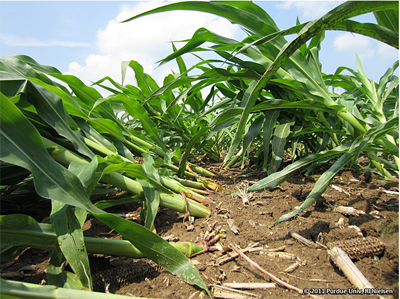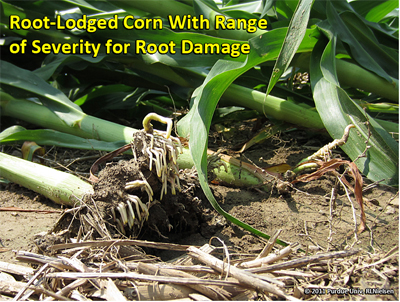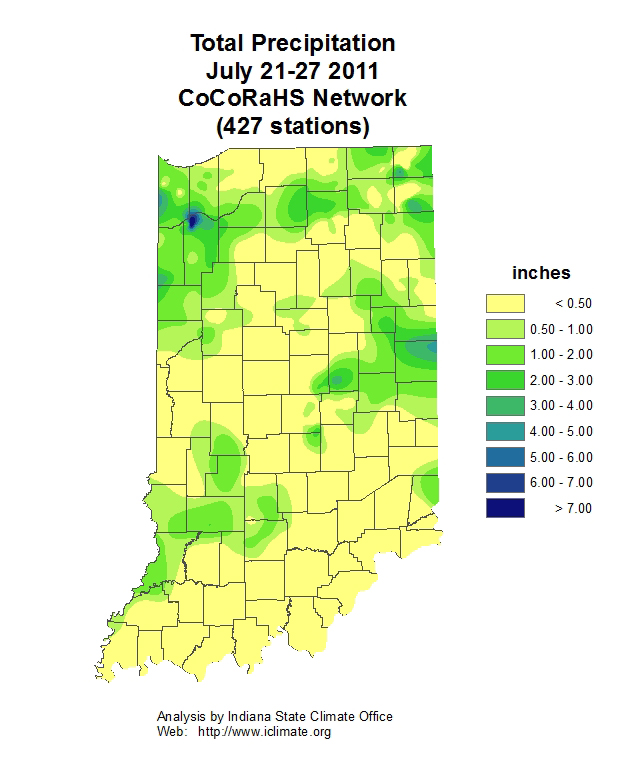- Soybean Aphid: Starting to Show Up in Northern Indiana Soybean (but do not panic yet)
- Western Corn Cutworm Adult Pheromone Trap Report
- Black Light Trap Catch Report
Soybean Aphid: Starting to Show Up in Northern Indiana Soybean (but do not panic yet) - (Christian Krupke and John Obermeyer)
• Aphids, though mostly low levels, are beginning to be found in many fields.
• Recent rains, moderate temperatures, and soybean growth spurt may favor aphids.
• Concentrate scouting effort on the new growth in the upper soybean canopy.
Reports have just come in of soybean aphids beginning to establish in the new growth of soybean foliage. Although there have been rumored fields over threshold and being treated, those contacting us (thanks to Troy Jenkins and Dan Childs) have only seen low numbers, but aphids are being found on the majority of the plants. This certainly indicates that scouting soybean fields should begin in earnest immediately. We are able to find aphids in many fields around Tippecanoe County, but again numbers are very low and have a lot of building to do to reach threshold before the R6 stage.
New soybean growth being colonized by aphids, note the adult female giving live birth
As we stated in earlier Pest&Crop issues, aphids have been relatively scarce this year. Since numbers in the upper Midwest haven't flared, we don't suspect that winged aphids have migrated from those areas and descended on Indiana. To support that, those finding aphids are not seeing many with wings. The extreme heat last week and in the latter part of this week is not helpful for aphid survival and reproduction. They don't die as a result of the heat, but they do not reproduce very quickly at temperatures in excess of 90 degrees.
It is likely that recent rains and more tolerable temperatures have spurred on the few aphids that lurked in the canopy unnoticed.
Be certain to look for aphids on the backside of soybean's newest growth
The rains have certainly encouraged new growth in soybean. That new growth is rich in nutrients that favor aphid fecundity and development. Soybean fields that are in the early R growth stages, especially in the northern counties, should be scouted soon. Concentrate on the backsides of new growth in the upper canopy and on the newly developing pods. Again, the vast majority of Indiana soybean fields have virtually no aphids in them. However, they are out there and some populations will be increasing and marching toward the magic number of 250 aphids/plant. Don't let your fields be among those that are not scouted until they are over threshold – take the time for a quick survey of 20 plants throughout the field.
Use the following treatment threshold guide determined by soybean growth stage:
Treatment threshold guide determined by soybean growth stage
Click here to see the Black Light Trap Catch Report
![]()
Click here to see the Western Bean Cutworm Adult Pheromone Trap Report
![]()
Profitability of Fungicides and Insecticides in Soybean (Ryan Henry, Kiersten Wise, Bill Johnson, and Christian Krupke)
• Purdue research indicates that yield increases in soybean from fungicide and insecticide applications to soybean are inconsistent.
As soybeans move from flowering into beginning pod (R3) in Indiana, questions have arisen about applying fungicides and insecticides to soybean to increase or protect yield. Currently there is low foliar disease pressure in Indiana soybeans. However, many growers are interested in applying fungicides for other benefits, including retention of green leaf area, which may lead to an extended period of seed fill and higher yields. In addition, insecticide applications have been included in this concept and are promoted as increasing yields, even in the absence of significant insect pressures. The question remains whether such a management practice will result in consistent yield increases that will offset the added cost of the chemicals.
Fields trials were established in 2009 and 2010 at three locations in Indiana: the Pinney Purdue Agriculture Center (PPAC), in LaPorte County, the Agronomy Center for Research and Education (ACRE) in Tippecanoe County, and the Southeastern Purdue Agriculture Center (SEPAC) in Jennings County. All fields received Canopy DF pre-emergence herbicide about one month prior to planting. Our soybean management program consisted of 22 fl oz glyphosate at growth stage V3 or R2, 6 fl oz of the strobilurin fungicide Headline® fungicide at R2 or R4, and 3 fl oz of the insecticide Warrior® at R4 (Table 1). Trials were rated for disease and insect pressure throughout the season, however, no significant pressure was found in any trial location in 2009 or 2010.
| Table 1. Treatments applied to soybean during the 2009 and 2010 growing seasons. Glyphosate applications were applied at 22 fl oz/A at V3 or R2 in all treatments. | ||
| Treatments | Growth Stage | Rate (fl oz) |
| Glyphosate only (Control) | V3 or R2 | 22 |
| Headline | R2 | 6 |
| Headline | R4 | 6 |
| Warrior | R4 | 3 |
| Headline followed by Warrior | R2 followed by R4 | 6, 3 |
| Headline + Warrior | R4 | 6+3 |
In 2009, significant yield benefits were only observed in soybean receiving Headline at growth stage R4 (Figure 1). This treatment yielded, on average, 2 bu/A higher than the control group, which was 43 bu/A. The treatment of Headline at R2 followed by Warrior at R4 also resulted in mean yield of 45 bu/A, but this treatment was not significantly greater than the control due to higher variability in the results. Warrior insecticide did not increase yield beyond a herbicide application.
Figure 1. Yield of soybean in 2009 averaged over all treatments and locations. All treatments including glyphosate at either growth stage V3 or V2. The control treatment is glyphosate at V3 or $2. Yield increases deemed significantly different than the control treatment at the P=0.05 level are marked with an astrisk.
Yield increases were observed when insecticide was included in the soybean management program in 2010 (Figure 2). However, the yield from a Headline treatment was the same as a yield from glyphosate alone. When both Headline and Warrior were used together, yields were about 10 bu/A greater than glyphosate alone. These results suggest that insect populations were greater in 2010 than in 2009 at the field locations used in this study, but were not measurably detectable.
Figure 2. Yield of soybean in 2009 averages all over treatments and locations. All treatments included glyphosate at either growth stage V3 or R2. The control treatment is glyphosate at V3 or R2. Yield increases deemed significantly different than th congtrol treatment at the P=0.05 level are marked with an astrisk.
The decision to incorporate additional pesticides, like fungicides or insecticides, into a management program is ultimately based on economics. Of the treatments included in our analysis, a single application of glyphosate gave the highest average net return of $435/A (Table 2). While additional treatments like a tank mixture of Headline and Warrior at R4 could result in higher net returns (1128 $/A), these treatments were not always profitable because of the added pesticide and application costs and the lack of consistent yield increases. Keep in mind that these numbers do not take into consideration other farm-related costs such as rent, taxes, labor, etc. An individual grower's net return will not always be the same as those returns presented in Table 2, but the take home message is that fungicides and insecticides were not as cost effective as the glyphosate alone due to the inconsistent yield response.
Our results indicate that yield increases due to fungicides and insecticides are possible under conditions of below pest thresholds but consistent yield increases were not observed. Likewise, the additional cost of these pesticides and the variability of soybean market prices can influence the profitability of their use. According to our analysis, soybean growers will rarely economically benefit from their application. Therefore, we recommend that growers base their decision to apply a fungicide or insecticide on the presence or absence of significant fungal or insect pressures in their fields.
| Table 2. Average net returns for 2009 and 2010 treatments applied to soybean. Values are based on the five-year historical soybean prices, yield data from the present study, and expected pesticide costs for 2011. Prices for input costs are based on estimates from the 2011 Purdue Crop Cost & Return Guide (ID-166-W). The net returns do not include factors such as rent, taxes, labor, premiums, etc. The economic analysis software SIMETAR was used to generate this data. | ||||
| Treatment | Timing | Mean | Min | Max |
| -------- $ Acre-1 -------- | ||||
| Glyphosate | V3 | 435 | 40 | 999 |
| Headline | $2 | 406 | 35 | 862 |
| Headline | R4 | 420 | 33 | 1003 |
| Warrior | R4 | 385 | -65 | 1043 |
| Headline followed by Warrior | R2 followed by R4 | 381 | -28 | 988 |
| Headline + Warrior | R4 | 384 | -16 | 1128 |
![]()
VIDEO: Goss's Bacterial Wilt on Corn - (Kiersten Wise and John Obermeyer)
Goss's bacterial wilt was first confirmed in Indiana on popcorn in 2008 (Pest&Crop #20, August 18, 2008). The following video was shot in northern Indiana on July 27, 2011. It is intended to assist in field identification, understand circumstances that favor its development, and presents possible management strategies. Click on the video:
![]()
Prospects of Recovery for Root-Lodged Corn – (Bob Nielsen)
Scattered storms across Indiana in the past week or so flattened hundreds, if not thousands, of acres of corn. In contrast to stalk breakage, these flattened fields are the result of corn stalks being partially uprooted by strong winds and literally laid flat to the ground. Thus, the technical term for such flattening is "root lodging", not "stalk lodging".
Once head-high corn plants, now flattened by wind
The severity of the root lodging varies among and within fields, depending on the severity of the winds and the amount of soil saturation that accompanied the winds. The severity of root lodging was also influenced by the relative rooting depth of a field or area within a field. This growing season has not been conducive for deep rooting primarily because of shallow soil compaction created by pre-planting tillage operations and during the planting process itself. Soggy soils in the weeks after planting were not conducive for deep rooting. Excessively dry surface soils in recent weeks, coupled with shallow soil compaction layers, have not been conducive for further root development. Hybrids themselves vary naturally for root development and, thus, for susceptibility to root lodging.
Even though the natural response after walking a flattened field of corn is to assume catastrophic yield loss, there is an opportunity for such damaged fields to partially recover depending on the growth stage at which the damage occurred and the degree of root damage.
Others have speculated on the range of yield losses that may occur from flattened corn (see Related Reading below). Generally speaking, the younger the growth stage, the greater the opportunity for partial or perhaps even full recovery from such root lodging. The severity of root damage also influences the degree of recovery from root lodging.
Stage of Growth
Late-planted fields that are 1 to 2 weeks away from tasseling have the capacity to respond to the flattening because their stalks are still elongating. The upper stalks of these nearly horizontal plants will bend or "goose-neck" as stalk elongation continues. With time, damaged fields may appear to have fully straightened up when in fact the lower stalks are still leaning severely. However, the good news with this type of "recovery" is that later-occurring pollination may be fairly successful if both tassels and silked ears are "lifted up" by the "goose-necking" of the elongating stalks.
Once head-high corn plants, now flattened by wind
Once head-high corn plants, now flattened by wind
Goose-neck corn
Earlier-planted fields already pollinating or beyond when flattened simply do not have as much capacity to straighten up or "goose-neck" because stalk elongation is essentially complete by tasseling. Fields that were beginning or within days of beginning to pollinate are particularly susceptible to yield loss when the field is flattened by wind because both tassels and silks are not only near to the ground but also partially covered by the leaves of neighboring plants also laying flat. Pollen is not shed properly, silks are not exposed properly to pollen, and kernel set will subsequently range from zero to poor.
Fields that were already beyond pollination and into early stages of grain filling when the wind damage occurred suffer the same inability to straighten up significantly after a flattening event. Photosynthesis will be severely curtailed within the flattened canopy because of the significant shading of plants by other plants. Kernel abortion in such flattened fields could be significant.
Extent of Root Damage
The other factor that influences the degree of recovery from such flattening events is the extent of root damage suffered by the individual plants. Less root damage means more opportunity to recover and vice versa. The ability for compensatory root development is also influenced by whether soil moisture is adequate or not. Thankfully, many of the damaging storms also dropped 2+ inches of much-needed rain. Nevertheless, the root regeneration ability of damaged plants will play a role in determining the impact of the flattening event.
Other Complications
There is some concern that flattened corn will be more susceptible to foliar disease because of the proximity to the soil surface and possible higher humidity levels within the flattened canopy. Alison Robertson, Iowa State University, addresses the question of whether flattened fields should be sprayed with foliar fungicides in her recent article. My take on her comments is that benefits to such fungicide applications are NOT assured.
Root-lodged corn with range of severity for root damage
Root-lodged corn with range of severity for root damage
Let's say you are lucky and your flattened fields straighten up enough to successfully pollinate. Then let's say that grain filling occurs without a hitch and ear size is acceptable. Now think about those "goose-necked" lower portions of the stalk and how they relate to the center of gravity created by those acceptable ear sizes situated higher up the stalk. If stalk rots or simply stalk cannibalization develop late in the grain filling process, those "goose-necked" plants will likely be at greater risk of stalk breakage prior to harvest.
A final consequence of "goose-necked" fields will be the increased challenges of grain harvest. First of all, it may be difficult to harvest "on the rows" because the "rows" you will see from the combine cab will be the tops of "goose-necked" plants. That headache plus the possible greater risk of stalk breakage noted earlier will easily translate into a frustratingly slow harvest. Growers may want to consider arranging for combine reels or similar header attachments to aid in gathering downed corn into the header.
Related Reading
Elmore, Roger. 2011. Wind and Corn. Integrated Crop Management News, Iowa State Univ Extension. [online] Available at <http://www.extension.iastate.edu/CropNews/2011/0712elmore.htm> [URL accessed July 2011].
Lauer, Joe. 2011. Yield Response of Flattened (Lodged) Corn. Agronomy Advice, Univ of Wisconsin Extension [online] Available at <http://corn.agronomy.wisc.edu/AA/A086.aspx> [URL accessed July 2011].
Nafziger, Emerson. 2011. Wind Damage in Corn. The Bulletin, Univ of Illinois Extension. [online] Available at <http://bulletin.ipm.illinois.edu/article.php?id=1534> [URL accessed July 2011].
Robertson, Alison. 2011. Thoughts on Spraying Downed Corn with a Fungicide. Integrated Crop Management News, Iowa State Univ Extension. [online] Available at <http://www.extension.iastate.edu/CropNews/2011/0713robertsona.htm> [URL accessed July 2011].
Thomison, Peter. 2011. Effects of Wind Lodging on Corn Performance. C.O.R.N., Ohio State Univ Extension. [online] Available at <http://corn.osu.edu/newsletters/2011/2011-22/effects-of-wind-lodging-on-corn-performance> [URL accessed July 2011].
![]()














